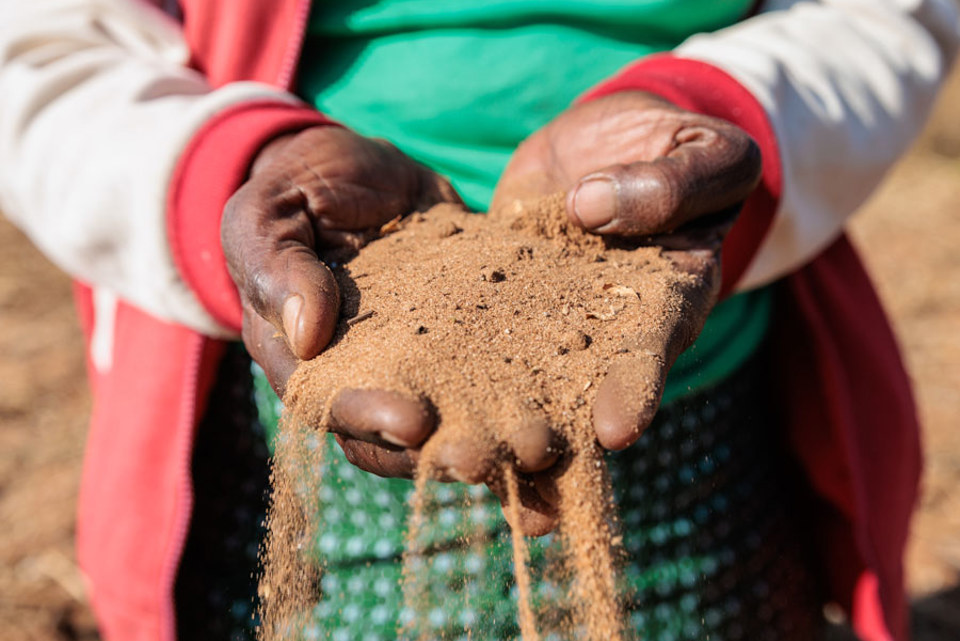Food Insecurity in Zimbabwe

Priscilla holding a bowl of sorghum. Photo: Caritas Australia.

Priscilla lives in Hwange district, north-western Zimbabwe. Photo: Richard Wainwright/Caritas Australia
Meet Priscilla
Priscilla lives with her husband and two grandchildren in the Hwange region of Zimbabwe, where the family has a farm featuring crops, cattle and chickens. All three are critical in supporting the family, not only in terms of growing enough food to eat but having surplus to sell and bring in income.
In the Hwange region, the impacts of climate change have been creating major issues for those who depend on agriculture for their livelihoods, with erratic rainfall patterns, extended dry spells, high temperatures and poor soil contributing to lower crop yields and less income.
What is food insecurity?
Food insecurity is the name we give to the issue of people being vulnerable to not having enough to eat. It can be driven by a range of factors including drought, displacement, conflict and high prices.
Food insecurity is a massive global issue with over 828 million people facing hunger worldwide. In Africa. ongoing drought, severe flooding and conflict have caused widespread malnutrition and driven millions of people from their homes. Food prices are also soaring due to ongoing global issues, which is compounding the issue of food insecurity in the region.
828 million people worldwide
don't have enough to eat
7.9 million people in Zimbabwe
live in extreme poverty
Millions in Africa
have been driven from their homes due to food insecurity
Priscilla's family and food insecurity
All of this led to Priscilla's community becoming increasingly vulnerable to food insecurity. Rain-fed agriculture is no longer reliable for farming and long dry spells have meant many families are at risk of extreme hunger. Other factors in Zimbabwe that exacerbate food insecurity include hyperinflation, widespread poverty and political instability. More than half of Zimbabwe’s population, 7.9 million people, live in extreme poverty.
During times of intense drought and food shortages, Priscilla had to commute to the town centre and wait in long queues to collect food.

Priscilla clutches dry soil amidst a drought on her farm in Zimbabwe. Photo: Richard Wainwright/Caritas Australia
“It was stressful because we didn't know what to give our children because there was nothing to give them.”

Priscilla with eggs from her poultry farming. Photo: Richard Wainwright/Caritas Australia
How Priscilla thrived
Priscilla joined the Zimbabwe Integrated Community Development Program, implemented by partner Caritas Hwange and funded by Caritas Australia. Through the program, Priscilla and her community learnt conservation farming techniques to grow drought-resistant crops to help mitigate the effects of climate change.
Priscilla was able to produce a bumper harvest in her first year of practicing in conservation farming and used the money she earned to start poultry farming, selling eggs to add to the family's income. This means she can now pay for her grandchildren's school fees, books and stationery.
Priscilla also used the funds from her harvest to start poultry farming, where she can sell eggs to pay for her grandchildren’s school fees, books and stationery. The poultry farming also provides a safety net for Priscilla and her family during times of hardship, like the current drought.
In addition to conservation farming training, Caritas Hwange has helped Priscilla boost her food security through a range of activities, including participating in a community nutrition garden to grow and sell vegetables, and rehabilitating the dip tanks to keep her cows healthy and reduce the prevalence of tick-borne diseases.
"Caritas Hwange came in with the idea of implementing Gachompo (conservation farming), which tremendously improved our crop germination rates hence the yields. With Gachompo, minimum rainfall is sufficient to support growth of our crops as the method ensures better water retention by the soil. The introduction of Gachompo also meant reduced use of livestock for farming and more time for them to graze.”












